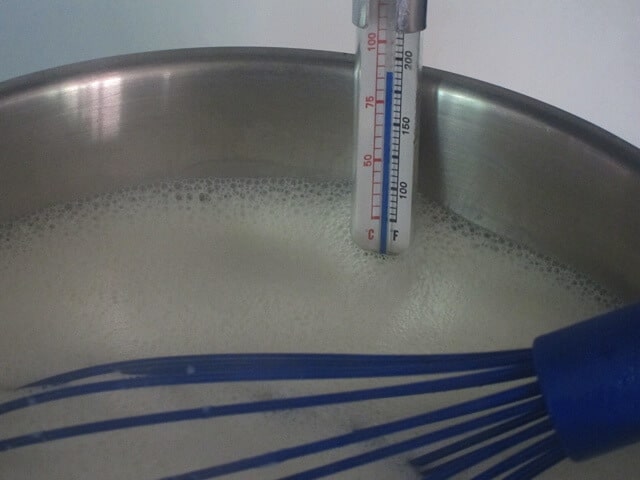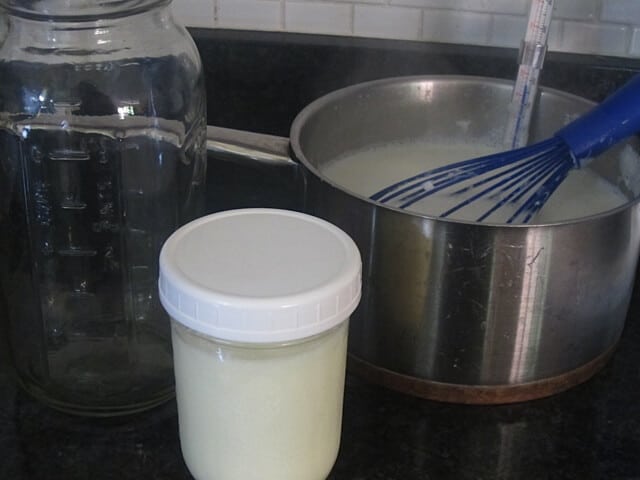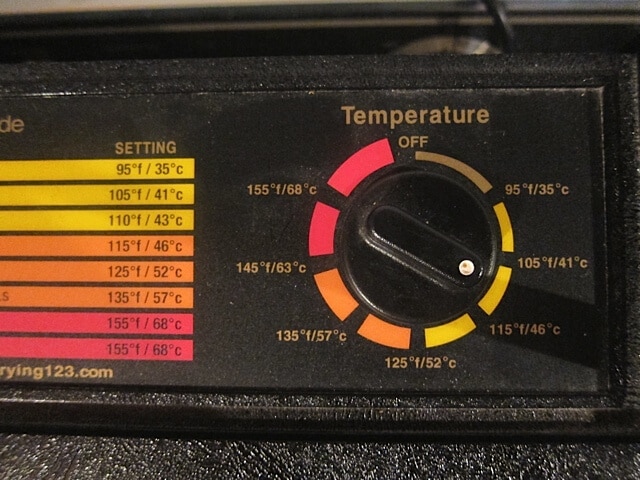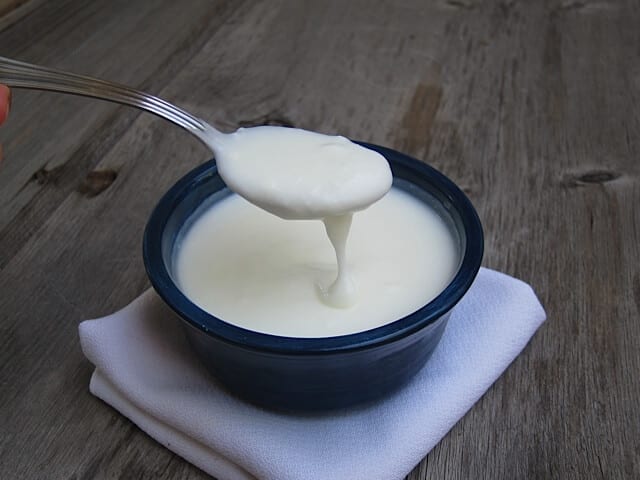
One of the foods that I make every week is homemade yogurt. Not only do I know that it is the healthiest yogurt that we can consume, but we save a TON of money doing it this way. For less than the price of one container of yogurt from the store, I can make twice the amount. I will admit that I was intimidated to start making it. I thought that it would be a long and very detailed process. I was wrong. Once I learned how to make yogurt I quickly make it into an easy process that fits right into our weekly routine, with very little effort. I want to share my method with you, so you can save money and nourish your family too!
Ingredients:
- 2 quart whole milk (1/2 gallon)
- 1/2 cup yogurt (plain, unflavored, and with probiotic strains added AFTER pasteurization) or a starter culture — like this one
- Optional: if you like your yogurt thick, then add in one Tbsp of gelatin with the culture — where to find
Equipment:
- Medium stainless steel pot — like this
- Candy thermometer — like this
- Large glass jar — like this
- Dehydrator — I use this one
Directions:
- Put one quart of milk into a clean pot and heat slowly on a medium heat until the temperature reaches 180°F

- Stir the milk from time to time to keep the bottom from scorching, the purpose in heating the milk to this temperature is to kill any bacteria that might be present and interfere with the yogurt making culture. You do not want to breed bad bacteria in your yogurt!
- Once you reach 180°F, turn the heat off and allow to cool to 80°F. I like to cover mine with a clean cotton towel while it cools so no critters can get in
- You can use a yogurt starter, or store bought yogurt to make your yogurt
- If you use a starter culture, then follow the instructions on the package
- If you use store bought yogurt as your starter, make sure it contains Lactobacillus Acidophilus, Streptococcus Thermophilus, and Lactobacillus Bulgaricus. It must not contain Bifidus/Bifidum bacteria. It should also be free from any additives, artificial colors, or artificial flavors. The culture must be active, it cannot be pasteurized after the cultures were added.

- Add the starter to the milk and stir well (if you want thick yogurt, then this is when you would add the gelatin too)
- Pour into a large clean glass container
- Cover the jar with a clean cloth or paper towel
- Place into your dehydrator and set the temp to 110°F


- Leave in the dehydrator, undisturbed, for 24 hours
- When it has been in there for 24 hours, remove and let cool on your countertop

- Then place in fridge for another 8 hours, undisturbed. Do not mess with it, or it will not set up properly
- Stir and enjoy!

Note: if you do not have a dehydrator, you can also place the yogurt in a cooler, wrapped with a towel. Place a pot of boiling water in the cooler and close it up. Make sure that the inside of the cooler remains warm for 24 hours. This method is a bit more tricky with temperature control. I have even seen yogurt made in a crockpot. I don’t generally recommend this method because the low setting on a crockpot is typically higher than 110*F. For best results, it is worth buying a high quality dehydrator or inexpensive yogurt maker
Additional tips:
- Culturing time is important to making good yogurt. The amount of time the yogurt cultures depends on taste and texture preference. In general, the longer yogurt cultures, the more tart and thick it will be. Toward the limit of culturing time, the yogurt may begin to separate into solid (curds) and liquid (whey). The whey is quite nutritious and can be strained off to use in cooking or culturing, or it can be stirred back in to the yogurt
- Separation is usually the result of yogurt’s culturing either too long or too fast. Once yogurt begins to separate, it is not long before the bacteria will begin to die off
- There is a 2-hour cooling-off period for thermophilic yogurt, to help ease the transition between culturing temperature and refrigerator temperature. Finished yogurt should be refrigerated for at least 6 hours to halt the culturing process. Once the fermentation has been stopped, it will not restart even if the milk is brought back to room temperature
- If a thicker yogurt is preferred, draining whey from the finished yogurt is another option. Draining whey produces thick, Greek-style yogurt. You can strain the yogurt through a cheese cloth placed in a strainer over a bowl, the whey drains off through the bottom and into the bowl and the thick yogurt remains on top
Watch my video that shows how I make yogurt in my kitchen below

Resources:
- https://pecanbread.com/f/tanya/yogurthowto.html
- https://www.culturesforhealth.com/how-to-make-yogurt
Original article and pictures take realfoodrn.com site
Комментариев нет:
Отправить комментарий